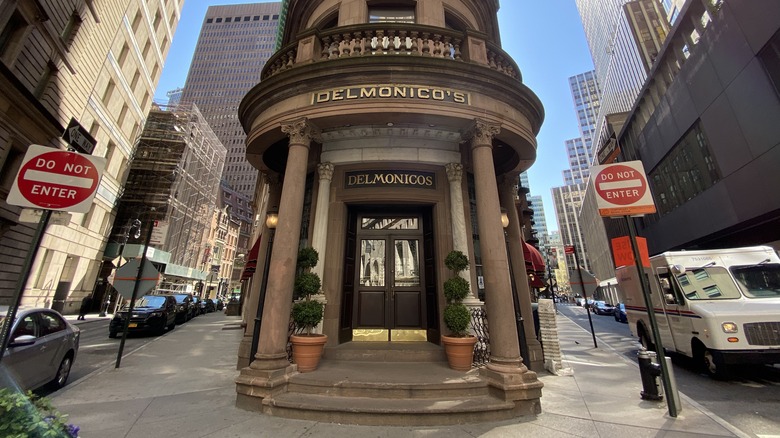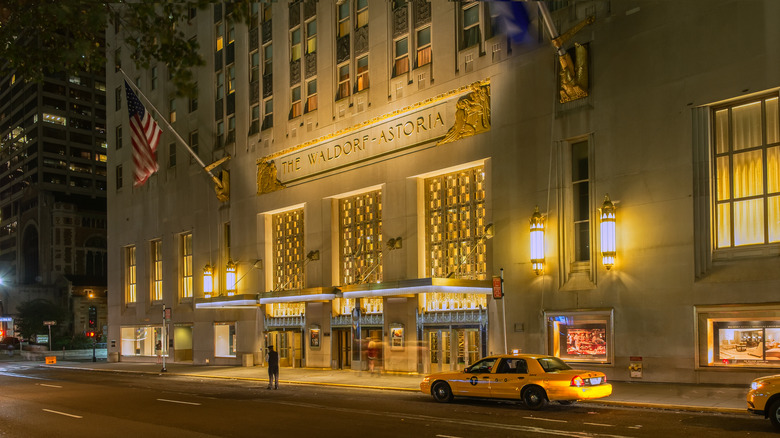The Warring Theories About How Eggs Benedict Was Invented
No brunch menu is truly complete without eggs Benedict. It's a classic, and yet it never seems to grow old, largely thanks to its amazing versatility. Eggs Benedict is a dish that naturally lends itself to adaptation. Innovative chefs can morph it to fit regional ingredients and contemporary food trends. The traditional preparation of English muffins topped with Canadian bacon, poached eggs, and hollandaise sauce will always be a hit, but why stop there? The base can be traded for toast or biscuits, the hollandaise sauce for a béarnaise or mornay, and the Canadian bacon for just about anything from strip bacon to smoked salmon to your leftover holiday ham.
At this point, eggs Benedict has been reimagined around the world with elements of many cuisines, but at its core, this dish is an authentic American icon. It was born in New York City at the tail end of the 19th century ... and that's about all we know of its origin story. For such a ubiquitous dish, and one that isn't that old in the grand scheme of things, it's surprising how little we know of its origins, and most intriguingly, the real identity of Benedict. The greatest challenge in sorting out the history of eggs Benedict is the fact that two parties claim to have invented it, and they just so happen to be two of the most storied restaurants in New York City history.
The Delmonico's theory
The first restaurant laying claim to the invention of eggs Benedict is the iconic Delmonico's Steakhouse. Considered to be the first fine dining restaurant in the United States, the nearly 200-year-old institution introduced Americans to à la carte cuisine, printed menus, white tablecloths, and even the word "restaurant" itself. Delmonico's also claims to be the origin of multiple dishes, including lobster Newberg, baked Alaska, and the wedge salad, but eggs Benedict is its most controversial claim to fame.
The story begins sometime in the 1860s. At the time, Delmonico's was frequented by a couple identified as Mr. and Mrs. LeGrand Benedict. So often did they dine at the restaurant that they eventually became bored of the menu and requested something novel. Lucky for them, Delmonico's kitchen was at the time run by chef Charles Ranhofer. A native of France, Ranhofer had trained in Parisian restaurants and even served as the chef de cuisine for Prince Henin of Alsace. If there was ever a man fit for the Benedicts' challenge, it was he.
It's unclear what inspired Ranhofer to invent eggs Benedict, but his claim to the dish is well-founded. In 1894, Ranhofer published The Epicurean, an expansive cookbook containing nearly 4,000 recipes. Among these is the first definitive mention of eggs Benedict, prepared exactly as it classically is today. However, the dish's name is spelled "Eggs à la Benedick," not "Benedict," which throws the identities of Mr. and Mrs. LeGrand Benedict into question.
The Waldorf theory
The other restaurant laying claim to eggs Benedict is the dining room of the famed Waldorf-Astoria Hotel. Their version of the story credits the invention to a Wall Street stockbroker named Lemuel Benedict, who frequently dined there. Benedict was somewhat of a playboy, a controversial figure in New York's Gilded Age, whose hedonistic antics and penchant for gossip frequently landed him in tabloids. His drinking was particularly notable, with the stockbroker carrying a cane with a hidden liquor flask built into it.
Given this reputation, it's hardly surprising that Lemuel reportedly invented eggs Benedict as a hangover cure. As the story goes, he went to the Waldorf one morning following a night of heavy drinking and ordered poached eggs, bacon, toast, and a pitcher of hollandaise. He then proceeded to pile these ingredients on top of one another to create the dish that now bears his name.
Benedict's invention caught the attention of the Waldorf's maître d'hôtel, Oscar Tschirky, who was a culinary innovator in his own right (he is credited with inventing the original Waldorf salad). Tschirky added Benedict's invention to the menu but swapped out the bacon and toast for ham and English muffins. There's one troublesome detail about the Waldorf theory though. It wasn't reported until 1942, when in an interview with The New Yorker Lemuel Benedict claimed to have invented the dish in 1894, when Charles Ranhofer put his recipe for eggs à la Benedick in print.
One more theory...
Many attempts have been made to decipher the origins of eggs Benedict, and they almost always lead back to the dueling claims of Delmonico's and the Waldorf-Astoria. However, there is one other theory that surfaced in a 1967 New York Times article by the legendary food writer Craig Claiborne. While Claiborne praised eggs Benedict as "conceivably the most sophisticated dish ever created in America," he professed to have known little of its origins, until he received a letter from a man named Edward P. Montgomery.
Montgomery claimed that the real namesake of eggs Benedict was Elias Cornelius Benedict, a Wall Street banker and noted yachtsman who went by the nickname Commodore. According to the letter sent to Claiborne, the Commodore invented eggs Benedict in his own kitchen, and notably used round slices of toast for the base rather than an English muffin. This theory is certainly the weakest of the three tales related here, with no date given for the invention. Furthermore, Montgomery provided no explanation of how he learned this story, or what connection he had to the Commodore. However, given the Commodore's notoriety and Clairborne's reputation as America's leading food expert, this flimsy theory has stubbornly persisted.



